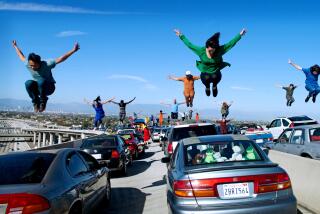SIGHTS AROUND TOWN : Roots of the Past : A Conejo Valley Art Museum exhibit takes a revealing look back at Jungleland’s original grandiose plans.
What if you planned an amusement park that never came to be? What if someone unearthed and displayed the blueprints 30 years later? These are the questions underlying the peculiar, sometimes fascinating, sometimes unintentionally campy exhibition of Jungleland plans now at the Conejo Valley Art Museum.
What we have here is a tribute to a dream that never came to fruition, evidently because of short money and the looming competition of Disneyland to the south. Jungleland, such as it might have been, exists now only in the formative imagery of drawings and elaborate plans by Lyle Wheeler.
What an exotic, kitschy, outlandish, contradictory, animalistic wonderland it would have been. It would have been a place where visitors could have enjoyed the Insect Kingdom, the Indian Fight Ride, Chimpland and the African Basket Ride--including tunnels, whirling bats, a Pygmy Compound and Idol Land.
Visitors could watch big cats roaming the grounds, or they could shoot ‘em (facsimiles, that is) on the Safari Gun Ride. Ogle or pretend to kill, your choice.
It amounts to more than just an innocent display of drawings. The implications of Jungleland touch upon the peripheral vision of the movie industry, the history of Thousand Oaks and the very nature of grandiose creative notions.
The area known as Jungleland--now the site of another grand plan, this one calling for a new civic center and performing arts facility--has been a hot property in town since Louis Goebel set up his lion farm there in the 1920s. It was an early landmark around which Thousand Oaks gradually grew.
In 1955, Twentieth Century-Fox executives James Ruman and Sid Rogel bought the farm (so to speak) and added 158 acres to its original 20. Their intention was to build an amusement park that would include rides and animals roaming freely, to be observed by guests in trams overhead. They felt confident that, with the newly opened Ventura Freeway giving Angelenos access, Jungleland could be a major attraction.
Enter the late Lyle Wheeler, an architect, artist and set designer who worked on “Gone With the Wind” and other films. Wheeler’s drawings and far-flung ideas for Jungleland illustrate a real movie-biz, sky’s-the-limit zeal.
Perhaps the illusory, ephemeral medium of cinema provokes its practitioners to consider creation in three dimensions, something concrete and kinetic. At least it seems so with Wheeler, whose Jungleland vision incorporated elements of the circus, a zoo and a nature expo. One could speculate that it typifies the Southern Californian instinct to dazzle and to build a bigger, brighter mousetrap.
Other details from the drawings include umbrellas for tables resembling origami birds, a rubber plantation and a “tribal bandstand.” You get the feeling that these are concepts from someone who has watched, or made, too many movies.
Most of the plans on display were drawn around 1958. When Jungleland did open, it was a far, far more modest thing, and bad publicity dogged the place. A panther escaped in 1963, and Jayne Mansfield’s son was mauled by a lion in 1966. They closed up shop in 1969.
And now, 34 or so years later, we look in on Wheeler’s plans for an outlandish Dr. Seussland, with a Bad-Animal-Catching Ride. That attraction, like the Jungleland exhibit as a whole, functions as an anatomy of an irrational idea, blending the conceptual stuff of Dr. Seuss with the contraptionism of Rube Goldberg. It’s can-do utopianism, by turns quaint, admirable, absurd and inspirational.
Art for eateries: Faced with an imperiled local art gallery scene, Ventura artist Laura Porakova has taken matters into her own hands and carved out a scene of her own on the wall space of restaurants.
In the nine months since her arrival from Colorado, Porakova’s own print works have been seen at See’s and at SoHO in Santa Barbara, as well as in the recently closed Palm Street Gallery in Ventura.
More recently, Porakova the curator has been bringing fine art to the Santa Barbara Sheraton’s restaurant, Zack’s. The third show she put together, which is on view through Friday, features established Santa Barbara artists Priscilla Bender-Shore and Pamela Zwehl-Burke.
Bender-Shore’s paintings of rock formations exert a mystical presence and a painterly gusto beyond the realm of realism. Zwehl-Burke’s delicate still-lifes with vegetables are whimsical, upon close examination. “The Birds and the Bees” tells a sly tale, as if a turnip (in the form of a sperm) and an egg have produced a brood of carrots.
On Saturday, a new show opens, featuring collages by Ursula Perl, ceramics by Vi Schultz and neon art by John Shephard. At the 5:30 p.m. opening, Lorence Burdorf, operator of the now-closed Palm Street Gallery, will show up for a performance piece entitled “Study of Light.”
The next show, based on the theme of primitive art, will include Santa Barbara artists Angela Beguhl and Aud Powlson, and also Ojai artists Ruth Farnham and Linda Taylor.
* WHERE AND WHEN
“Jungleland Theme Park Project 1958” at the Conejo Valley Art Museum, 193-A N. Moorpark Road, Thousand Oaks, through Feb. 9.
Works by Priscilla Bender-Shore and Pamela Zwehl-Burke, through Friday. Works by Ursula Perl, Vi Schultz and John Shepard, opening 5:30 p.m. Saturday. Both curated by Laura Porakova at Zack’s at the Beach, 1111 E. Cabrillo Blvd., Santa Barbara.
More to Read
Sign up for The Wild
We’ll help you find the best places to hike, bike and run, as well as the perfect silent spots for meditation and yoga.
You may occasionally receive promotional content from the Los Angeles Times.






